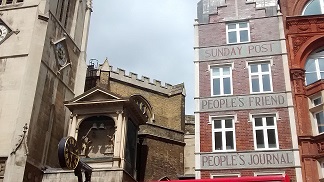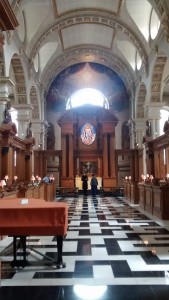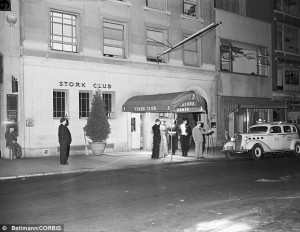The Poppy Denby Investigates novels are set in London in the early 1920s. In the first book, The Jazz Files, Poppy also visits Paris and in future books will be going further afield. Here are some of the main settings in London to help you visualise Poppy’s world.

Fleet Street
Fleet Street, London, has for centuries been known as the print and press street of the United Kingdom. Sadly, all of the newspapers and magazines have now moved their HQs elsewhere, but ‘Fleet Street’ remains synonymous with British journalism.

The Daily Globe is a made-up newspaper, but I imagine that it would be housed in a building like this. Although the Daily Telegraph has now moved is headquarters out of central London, this art deco masterpiece still stands and is now occupied by Goldman Sachs.


Poppy’s colleagues at the Globe enjoy a drink in Ye Olde Cock Tavern. This is a real pub, founded in 1554, and frequented by the likes of Charles Dickens and Samuel Pepys. In the Jazz Files Poppy’s editor, Rollo Rolandson, is worried that prohibition might be introduced into Britain as it had been in the United States in early 1920. This is a major plotline in book two of the Poppy Denby Investigates series, The Kill Fee. But the pub is still there in the 21st century and the author has had a drink in there to prove it.

In The Jazz Files, Poppy and her friends hide in St Bride’s Church. St Bride’s (named after St Bridget), which has been rebuilt on the same spot since Roman times, is known as the Journalist’s Church. The current interior was rebuilt after a German bomb hit the sanctuary in 1940 and has an altar dedicated to journalists who have died while covering conflicts. In The Jazz Files, Poppy and her friends are living in a world where the role of religion and even the existence of God Himself are being reassessed in light of the horrors of the Great War.
Chelsea
King’s Road, Chelsea, is where Poppy lives with her Aunt Dot. It is also the location of Delilah’s flat and Oscars Jazz Club. It was a well-to-do upper middle class area. Then, as now, it was the haunt of trend-setters and socialites. In the early 1920s it was the home of ‘Bohemian’ artists and creatives. It was also a hot-bed of left-leaning politicos. Poppy’s Aunt and her friends are part of a militant cell of the Women’s Social and Political Union called the Chelsea Six.

This 1920s watercolour by WE Fox is what I imagine Aunt Dot’s townhouse to look like.


And here’s what it looks like from the entrance hall. Note the interior looks very much as it would have in Edwardian times. Town houses like these were typically two – three storeys above ground with the basement housing the kitchen, scullery and possibly servants rooms. In the early 1920s live-in domestic staff were becoming increasingly unfashionable (or too expensive).

Delilah on the other hand would have lived somewhere like this …note the geometric shapes, typical of art deco style. In the 1920s old Georgian townhouses – terraces in particular – were being done up into swish apartments for London toffs. Many of them had family homes in the country as well. As the decade progressed, London professionals began buying the flats as their sole residence.
And Oscars Jazz Club would have looked similar to this picture of the Stork Club. For some interior shots and live footage of the jazz clubs, visit the ‘all that jazz’ page.

For further reading on architecture and daily life in London:
- Thibaud Herem’s London Deco (Nobrow Press, 2013)
- Janet and John Shepherd’s 1920s Britain (Shire Living Histories, 2010).
- A fabulous online resource of the history of Chelsea in the period is the Royal Borough of Kensington and Chelsea’s Virtual Museum.
Poppy Goes to New York
Book 3 in the Poppy Denby Investigates Series, The Death Beat, is set in New York when Poppy and her editor go there for three months to work on the New York Times. Poppy and her friends travel to New York on the oceanliner the RMS Olympic, sister ship to the Titanic. As you well know, the Titanic sank in 1912 (in The Jazz Files Elizabeth Dorchester’s mother, Maud, died on the maiden voyage, and in book 2, The Kill Fee, the parents of Delilah’s new boyfriend also went the same way). The Olympic was one of three sisters operated by the White Star Line between Europe and New York. The third ship, the Britannic, was sunk by a German underwater mine in 1916. But the Olympic survived and had a long and illustrious career until 1934 when she was finally decomissioned. Poppy and her pals travel in April 1921. I am beside myself to have found this incredible promotional film of life on board the Olympic. Just imagine what fun Poppy and her friends will! It’s 16 minutes long, so make sure you have a cup of tea at the ready – and don’t forget to turn up the sound.

I just love all this extra info!!! I love reading British historical mysteries and have gotten into the habit of using my cell to call up pics of houses, fashions, food, etc that, as an American (Proud Texan here!), I have no frame of reference for.
There aren’t enough stories such as Poppy’s that are set post WWI, a time of great social upheaval. Poppy’s world is very realistic. I love her background, that she isn’t posh, she has a wonderfully colorful Aunt with a most unique background and is struggling against sexism to make her own place in her new world. Something many women still do to this day!
Descriptions are great. I love using my imagination but with her/your website you’ve expanded what I’ve imagined . And I’m only half way thru the first book! Thank you!
Thanks for stopping by, Sylvia. And I’m so glad Poppy has found a new fan!
Thank you for ‘The Death Beat’, my wife and I thoroughly enjoyed the story. The description of life on board ship struck a chord with me, a reminder of stories my grandmother told me about her brother, A S Chatfield, who spent the interwar years on transatlantic liners serving as a purser, latterly as chief purser on the ‘Empress of Australia’. However, when Poppy Denby travelled to New York he was working on the ‘Mauritania’. Interestingly he retired to South Africa, settling in Ports Shepstone, Natal.
Hello Anthony. Thank you for stopping by. I’m very glad you enjoyed The Death Beat. Have you read the first two books? What I didn’t say in the notes at the back of The Death Beat is that my grandma cruised to New York in the 1930s and then again when she was retired in the 1970s. And my dad was a ship’s engineer on the same route in the 1960s so I’ve grown up with stories of life on the liners too.
Fiona, thanks for the message.
Yes, we have read, and enjoyed, the two previous books. My wife, Theresa, follows you on Facebook and twitter so we know when a new story is available. The stories are enjoyable and bring to life post-war Britain. Incidentally, my grandfather was a marine engineer.
Best wishes.
Oh my word, I heard your interview with BBC radio Newcastle this week and I thought to myself wow these books sound right up my street. When I got home from work I downloaded the very first book The Jazz Files and I’m so glad I did I listened to the whole book in just 3 nights. I was completely hooked. I myself am from Northumberland and I love period dramas and mystery. The first book had it all and I really can’t wait to start the next one.
Hello Leonie! Oh I’m so glad you enjoyed it. Isn’t Helen Keeley’s narration just brilliant? I love her interpretation of Poppy. Now you have five more books to look forward to, petal